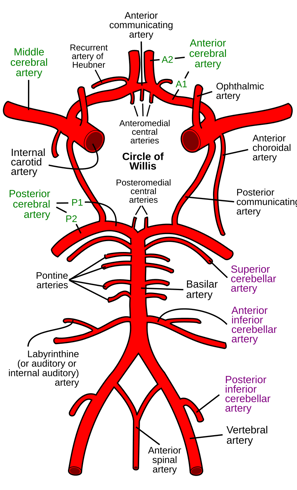Reversible Cerebral Vasoconstriction Syndrome (RCVS)
Reversible Cerebral Vasoconstriction Syndrome (RCVS) is a neurological disorder characterized by sudden, severe headaches and reversible narrowing of cerebral arteries. Often mistaken for other conditions like migraines or strokes, RCVS requires timely diagnosis and management to prevent complications. Let’s dive into the causes, symptoms, diagnosis, treatment, and key takeaways regarding this condition.
NEUROLOGYVASCULAR
Rishwin A R
1/30/20252 min read


Causes
RCVS occurs due to transient constriction of blood vessels in the brain (see figure). While the exact cause remains unclear, several triggers have been identified:
Medications: Use of vasoconstrictive drugs like selective serotonin reuptake inhibitors (SSRIs), triptans, and decongestants.
Illicit Substances: Cocaine, amphetamines, and cannabis can precipitate RCVS.
Hormonal Changes: Postpartum state or hormonal fluctuations.
High Blood Pressure Spikes: Sudden, severe hypertension episodes.
Emotional or Physical Stress: Intense exertion, sexual activity, or emotional distress can trigger episodes.
Symptoms
RCVS is primarily marked by thunderclap headaches, which are sudden, explosive headaches reaching peak intensity within seconds. Other symptoms include:
Nausea and Vomiting
Visual Disturbances
Seizures
Weakness or Numbness (in severe cases)
Diagnosis
Since RCVS mimics other serious conditions, thorough evaluation is crucial. The diagnostic process typically involves:
Clinical History and Examination: Sudden onset headaches with potential triggers.
Brain Imaging:
CT or MRI: To rule out hemorrhages or stroke.
Magnetic Resonance Angiography (MRA) or CT Angiography (CTA): To visualize vessel constriction.
Lumbar Puncture: To exclude conditions like subarachnoid hemorrhage.
Follow-Up Angiography: To confirm reversibility of vasoconstriction within 3 months.
Treatment
RCVS is typically self-limiting, resolving within 1 to 3 months. However, management focuses on symptom relief and preventing complications:
Acute Management
Pain Control: Avoiding NSAIDs (may worsen vasoconstriction), using calcium channel blockers like Nimodipine.
Blood Pressure Management: Ensuring stable blood pressure without excessive drops.
Seizure Control: Antiepileptic drugs if seizures occur.
Long-Term Management
Avoidance of Triggers: Discontinuing culprit medications and illicit drugs.
Lifestyle Modifications: Stress management, hydration, and a balanced diet.
Neurological Follow-Up: Monitoring vessel recovery through imaging.
Prognosis
The good news? RCVS is reversible! Most patients recover fully within weeks to months with proper management. However, complications such as stroke or brain hemorrhage can occur in severe cases, highlighting the importance of early recognition and treatment.
FAQs
1. Is RCVS a type of stroke?
No, but it can lead to stroke-like symptoms. Unlike a stroke, the vessel narrowing in RCVS is reversible.
2. How can I differentiate RCVS from migraines?
RCVS headaches are thunderclap headaches that reach peak intensity within seconds, whereas migraines build up gradually and often include aura.
3. Can RCVS be fatal?
Rarely. Most cases resolve fully, but severe complications like hemorrhagic stroke can occur if untreated.
4. How long does it take for RCVS to resolve?
Usually within 1 to 3 months with appropriate management.
5. Can RCVS recur?
Yes, but avoiding triggers significantly lowers the risk of recurrence.
Syndromes.xyz
Explore medical syndromes and their details here.
For Educational purposes only
The information on this site is not in any way, replacement for professional advice. Always consult your physician regarding personal queries
Connect
Support
syndromesxyz@gmail.com
© 2024. All rights reserved.
